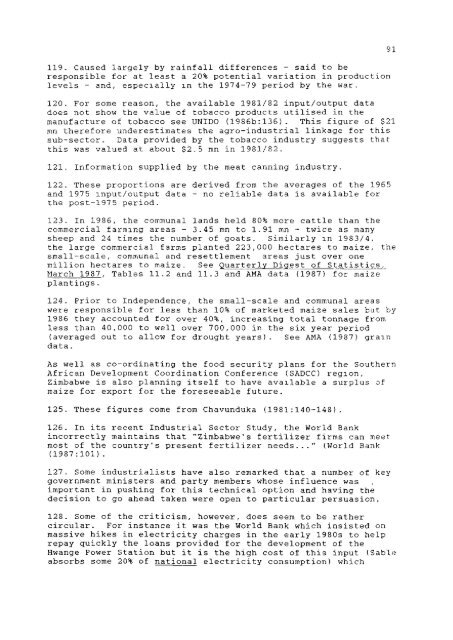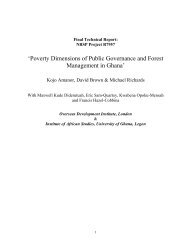Zimbabwe - Overseas Development Institute
Zimbabwe - Overseas Development Institute
Zimbabwe - Overseas Development Institute
You also want an ePaper? Increase the reach of your titles
YUMPU automatically turns print PDFs into web optimized ePapers that Google loves.
119. Caused l a r g e l y by r a i n f a l l d i f f e r e n c e s - s a i d to be<br />
responsible for at l e a s t a 20% p o t e n t i a l v a r i a t i o n i n production<br />
l e v e l s - and, e s p e c i a l l y i n the 1974-79 period by the war.<br />
120. For some reason, the a v a i l a b l e 1981/82 input/output data<br />
does not show the value of tobacco products u t i l i s e d i n the<br />
manufacture of tobacco see UNIDO (1986b:136). This f i g u r e of $21<br />
mn therefore underestimates the a g r o - i n d u s t r i a l linkage for t h i s<br />
sub-sector. Data provided by the tobacco i n d u s t r y suggests that<br />
t h i s was valued at about $2.5 mn i n 1981/82.<br />
121. Information supplied by the meat canning industry.<br />
122. These proportions are derived from the averages of the 1965<br />
and 1975 input/output data - no r e l i a b l e data i s a v a i l a b l e for<br />
the post-1975 period.<br />
123. In 1986, the communal lands held 80% more c a t t l e than the<br />
commercial farming areas - 3.45 mn to 1.91 mn - twice as many<br />
sheep and 24 times the number of goats. S i m i l a r l y i n 1983/4,<br />
the large commercial farms planted 223,000 hectares to maize, the<br />
small-scale, communal and resettlement areas j u s t over one<br />
m i l l i o n hectares to maize. See Quarterly Digest of S t a t i s t i c s ,<br />
March 1987, Tables 11.2 and 11.3 and AMA data (1987) for maize<br />
p l a n t i n g s .<br />
124. P r i o r to Independence, the s m a l l - s c a l e and communal areas<br />
were responsible for l e s s than 10% of marketed maize sales but by<br />
1986 they accounted f o r over 40%, i n c r e a s i n g t o t a l tonnage from<br />
less than 40,000 to w e l l over 700,000 i n the s i x year period<br />
(averaged out to allow f o r drought years). See AMA (1987) gram<br />
data.<br />
As w e l l as co-ordinating the food s e c u r i t y plans f o r the Southern<br />
A f r i c a n <strong>Development</strong> Coordination Conference (SADCC) region,<br />
<strong>Zimbabwe</strong> i s also planning i t s e l f to have a v a i l a b l e a surplus of<br />
maize f o r export for the foreseeable future.<br />
125. These f i g u r e s come from Chavunduka (1981:140-148).<br />
126. In i t s recent I n d u s t r i a l Sector Study, the World Bank<br />
i n c o r r e c t l y maintains that "<strong>Zimbabwe</strong>'s f e r t i l i z e r firms can meet<br />
most of the country's present f e r t i l i z e r needs..." (World Bank<br />
(1987:101).<br />
127. Some i n d u s t r i a l i s t s have a l s o remarked that a number of key<br />
government m i n i s t e r s and party members whose i n f l u e n c e was<br />
important i n pushing f o r t h i s t e c h n i c a l option and having the<br />
d e c i s i o n to go ahead taken were open to p a r t i c u l a r persuasion,<br />
128. Some of the c r i t i c i s m , however, does seem to be rather<br />
c i r c u l a r . For instance i t was the World Bank which i n s i s t e d on<br />
massive hikes i n e l e c t r i c i t y charges i n the e a r l y 1980s to help<br />
repay q u i c k l y the loans provided for the development of the<br />
Hwange Power S t a t i o n but i t i s the high cost of t h i s input (Sable<br />
absorbs some 20% of n a t i o n a l e l e c t r i c i t y consumption) which
















